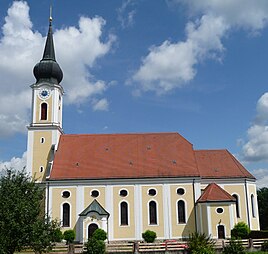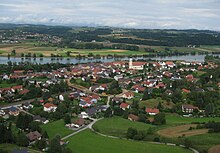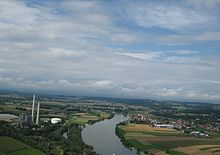Pleinting
|
Pleinting
City of Vilshofen on the Danube
Coordinates: 48 ° 39 ′ 31 ″ N , 13 ° 7 ′ 11 ″ E
|
|
|---|---|
| Height : | 310 m |
| Residents : | 1501 (May 25 1987) |
| Incorporation : | May 1, 1978 |
| Postal code : | 94474 |
| Area code : | 08549 |
|
The parish church of St. Stephen
|
|
Pleinting is a district of the city of Vilshofen on the Danube in the Lower Bavarian district of Passau .
geography
Pleinting is located on the Danube about five kilometers northwest of Vilshofen on federal highway 8 and the Regensburg – Passau railway line . From the north the Bavarian Forest and from the southeast its foothills, the Alkofener Heights , encircle the Danube, while in the west the Dungau opens up towards Künzing . In the southwest lies the Forstharter mountain ridge belonging to the Lower Bavarian hill country . Where the Danube enters its breakthrough valley is the former Pleinting market.
history
Until the 19th century

Numerous archaeological finds indicate the early settlement of the area. During excavations in March 1999, a skeleton, flint stones and ceramic pieces from the Neolithic Age were found in a field in the east of the market at a depth of 25 centimeters . Around 748 three farms, two vineyards and a forest were given to the Niederaltaich monastery here . The first parish church was built in 1050 based on the model of the Roman basilicas with a flat ceiling and no tower.
Pleinting came to the Hochstift Passau , which enfeoffed the nobles von Wessenberg with it. Heinrich von Wessenberg left the place to Count Rapoto II von Ortenburg in 1220 . On February 19, 1241, Count Rapoto III. Pleinting returned to Bishop Rüdiger von Passau and took it from him as a fief. In a document, Pleinting 1247 is referred to as the Ortenburg market. There was also a customs post here. As early as 1259, Rapoto's son-in-law and successor Hartmann I von Werdenberg sold the market to Heinrich von Niederbayern with the approval of the bishop . Since then Pleinting has belonged to the Wittelsbach family .
During the Landshut War of Succession , the walled Pleinting was besieged in vain by Palatinate and Bohemian troops, but as a precautionary measure it was burned down in Vilshofen on the night of December 20-21, 1504. On September 26, 1554, Duke Albrecht V gave the market place Pleinting the coat of arms, which showed a standing stag. The Thirty Years War resulted in the pillaging and cremation of Pleinting twice. Pleinting was hit by other severe fires in 1683, 1828, April 30, 1831 and December 1834. As a result, in order to prevent new fires, the street and the side streets were expanded, giving the market a friendlier shape. Only in the 19th century did Pleinting have four annual and cattle markets.
On September 20, 1860 Pleinting received a railway connection to the Regensburg – Passau railway line . On June 13, 1868, the Pleinting volunteer fire brigade was founded. SpVgg Pleinting was established in 1912.
Church building
The old parish church of St. Stephanus in Kirchbach, southwest of Pleinting, was closed in 1806 due to dilapidation. Instead, the Pleintingers set up their St. Nikolaus market chapel from 1404 as a parish church. However, the implementation of the plans for a completely new parish church for the 2600-strong community was delayed.
It was not until October 11, 1897 that the construction of the new St. Stephanus Church according to the plans of Johann Baptist Schott began at its current location. On October 12, 1903, the neo-baroque church was consecrated by the Passau bishop Anton von Henle . The original parish church, which was demolished in 1867 except for the choir, serves as a cemetery chapel. The neo-Gothic pilgrimage chapel Maria Hilf, built between 1857 and 1860, is also located on the Frauenberg.
Pleinting power station
The economic situation of the market town changed abruptly when in 1968/69 Bayernwerk AG / Ilse-Bayernwerke Energieanlagen GmbH (IBE) built a steam power plant with a capacity of 300 megawatts. Pleinting suddenly joined the ranks of the most taxable municipalities in Bavaria. In 1976 a second oil power plant unit with 425 MW was put into operation, increasing the gross output to 725 MW. The chimney of this power plant block is 180 meters high. This made the plant one of the largest power plants in Bavaria . At the same time, the location became the most important hub in the power distribution network in Eastern Bavaria.
In the energy program for Bavaria of July 28, 1978, the Bavarian state government secured the area for the expansion with a nuclear power plant of around 2,600 MW and, alternatively, with a conventional power plant block of at least 600 MW with cooling by wet cooling towers. These plans met with opposition from a citizens' initiative and numerous opponents. In the nineties, the heavy fuel oil powered power plant was converted to light fuel oil. On October 10, 2000 it was announced that the Pleinting oil power plant would be shut down. The reason for this was the merger of Bayernwerk AG and Preußen Elektra in July 2000 to form the largest private energy supplier in Europe, e.on, and the resulting overcapacity. The Pleinting power plant , which is in cold reserve, has been part of the Ingolstadt / Irsching power plant group since autumn 2008 . Since March 3, 2011, the shutdown was officially announced by the Supervisory Board resolution of February 2, 2011.
Incorporation to Vilshofen
As part of the regional reform in Bavaria , the Bavarian state government decided to incorporate Pleintings into Vilshofen. This was justified by the fact that the city of Vilshofen was only receiving the financial resources it needed to carry out its tasks as a medium- sized center through the integration of the financially strong Pleinting market . The incorporation was completed on May 1, 1978.
On June 17, 1989, the community of Markt Pleinting eV was founded, which has been trying to restore the Markt Pleinting since then. In April 1995 259 citizens accused in a civil suit before the Bavarian Constitutional Court unsuccessfully independence of the market Pleinting. Further petitions were rejected on the grounds that, according to Article 11, Paragraph 3, No. 3 of the municipal code, a two-thirds majority of the Vilshofen city council had to vote for the independence of the Pleinting market.
literature
- Joseph Klämpfl: The former Schweinach and Quinzingau. A historical-topographical description , 1855, reprint 1993, Neue Presse Verlags-GmbH, Passau, ISBN 3-924484-73-2 ( online at the Bayerische Staatsbibliothek)
- Ulrich Pietrusky, Donatus Moosauer: The Bavarian Forest - rediscovered in flight , Morsak Grafenau Verlag, 1985, ISBN 3-87553-228-7
- Franz Seraph Silbereisen: Origin of pilgrimage = chapel Maria-Hut, Maria-Hilf, Maria-Trost on the Frauenberge near Plainting , Regensburg, Manz, 1875.
Web links
- Website pleinting.de (private homepage)
- Kraftwerk Pleinting in the RegioWiki Niederbayern & Altötting
Individual evidence
- ↑ Bavarian State Office for Statistics and Data Processing (Ed.): Official local directory for Bavaria, territorial status: May 25, 1987 . Issue 450 of the articles on Bavaria's statistics. Munich November 1991, DNB 94240937X , p. 209 ( digitized version ).
- ↑ The traditions of the spelling of the first mention differ from one another: Joseph Klämpfl: The former Schweinach- and Quinzingau , 1855, quoted "Plidmuntinga", Ulrich Pietrusky: The Bavarian Forest in flight newly discovered , 1985 "Pliuntmuntingas".
- ↑ According to Klämpfl and Pietrusky, the courtyards were donated to Niederaltaich Monastery, but to Mondsee Monastery according to www.pleinting.de . Pietrusky mentions that the Mondsee Monastery also had properties in Pleinting at that time.
- ^ Federal Statistical Office (ed.): Historical municipality directory for the Federal Republic of Germany. Name, border and key number changes in municipalities, counties and administrative districts from May 27, 1970 to December 31, 1982 . W. Kohlhammer GmbH, Stuttgart and Mainz 1983, ISBN 3-17-003263-1 , p. 620 .




